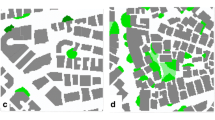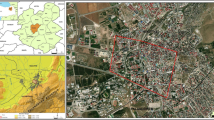Abstract
The outdoor environment is deteriorating in many tropical cities due to rapid urbanization. This leads to a number of problems related to health and well-being of humans and also negatively affects social and commercial outdoor activities. The creation of thermally comfortable microclimates in urban environments is therefore very important. This paper discusses the influence of street-canyon geometry on outdoor thermal comfort in Colombo, Sri Lanka. Five sites with different urban geometry, ground cover, and distance from the sea were studied during the warmest season. The environmental parameters affecting thermal comfort, viz. air temperature, humidity, wind speed, and solar radiation, were measured, and the thermal comfort was estimated by calculating the physiologically equivalent temperature (PET). The thermal comfort is far above the assumed comfort zone due to the combination of intense solar radiation, high temperatures, and low wind speeds, especially on clear days. The worst conditions were found in wide streets with low-rise buildings and no shade trees. The most comfortable conditions were found in narrow streets with tall buildings, especially if shade trees were present, as well as in areas near the coast where the sea breeze had a positive effect. In order to improve the outdoor comfort in Colombo, it is suggested to allow a more compact urban form with deeper street canyons and to provide additional shade through the use of trees, covered walkways, pedestrian arcades, etc. The opening up of the city’s coastal strip would allow the sea breeze to penetrate further into the city.













Similar content being viewed by others
Notes
Based on measurements from Colombo Meteorological Station 1970–2004. The station is located in a low-density, fashionable, residential neighborhood with significant green cover.
References
Ahmed KS (1994) A comparative analysis of the outdoor thermal environment of the urban vernacular and the contemporary development: case studies in Dhaka. In: Etzion Y, Erell E, Meir IA, Pearlmutter D (eds) Architecture of the Extremes. Proceedings of the 11th PLEA International Conference, Dead Sea, 3–8 July 1994. The Desert Architecture Unit, Ben-Gurion Univ. of the Negev (Israel), pp 341–348
Ahmed KS (2003) Comfort in urban spaces: defining the boundaries of outdoor thermal comfort for the tropical urban environments. Energy Build 35:103–110
Arnfield AJ (2003) Two decades of urban climate research: a review of turbulence, exchanges of energy and water, and the urban heat island. Int J Climatol 23:1–26
Ali-Toudert F, Djenane M, Bensalem R, Mayer H (2005) Outdoor thermal comfort in the old desert city of Beni-Isguen, Algeria. Clim Res 28:243–256
ASHRAE (1997) Handbook of fundamentals. American Society of Heating, Refrigerating and Air-Conditioning Engineers, Atlanta
ASHRAE (2004) Thermal environmental conditions for human occupancy, ASHRAE Standard 55–2004. American society of heating, refrigerating and air-conditioning engineers, Atlanta
Aynsley R, Gulson L (1999) Microclimate and urban planning in the humid tropics. RAPI 27th National Congress, 19–22 September 1999. Dept. of Lands, Planning and Environment, Darwin (NT), Australia
Baker LA, Brazel AJ, Selover N, Martin C, McIntyre N, Steiner FR, Nelson A, Musacchio L (2002) Urbanization and warming of Phoenix (Arizona, USA): impacts, feedbacks and mitigation. Urban Ecosystems 6:183–203
Correa C (1989) The new landscape: urbanization in the third world. Butterworth Architecture, London
de Dear RJ, Brager G (2001) The adaptive model of thermal comfort and energy conservation in the built environment. Int J Biometeor 45:100–108
de Schiller S, Evans JM (1998) Sustainable urban developments: design guidelines for warm humid cities. Urban Des Int 3:165–184
Deosthali V (1999) Assessment of impact of urbanization on climate: an application of bio-climatic index. Atmos Environ 33:4125–4133
Emmanuel R (2005a) An urban approach to climate sensitive design: strategies for the tropics. Spon Press, London
Emmanuel R (2005b) Thermal comfort implications of urbanization in a warm-humid city: the Colombo Metropolitan Region (CMR), Sri Lanka. Build Environ 40:1591–1601
Emmanuel R, Johansson E (2006) Influence of urban morphology and sea breeze on hot humid microclimate: the case of Colombo, Sri Lanka. Clim Res 30:189–200
Höppe P (1999) The physiological equivalent temperature - a universal index for the biometeorological assessment of the thermal environment. Int J Biometeorol 43:71–75
Humphreys MA (1996) Thermal comfort temperatures world-wide - the current position. Renew Energy 8:139–144
Johansson E (2006) Influence of urban geometry on outdoor thermal comfort in a hot dry climate: a study in Fez, Morocco. Build Environ 41:1326–1338
Matzarakis A, Mayer H (1997) Heat stress in Greece. Int J Biometeorol 41:34–39
Matzarakis A, Rutz F, Mayer H (2000) Estimation and calculation of the mean radiant temperature within urban structures. In: de Dear RJ, Kalma JD, Oke TR, Auliciems A (eds) Biometeorology and urban climatology at the turn of the millennium. Selected papers from the conference ICB-ICUC’99, Sydney 8–12 November 1999. World Meteorological Organization, WMO/TD No. 1026, Geneva, pp 273–278
McIntyre DA (1980) Indoor climate. Applied Science Publishers, London
Nakamura Y, Oke TR (1988) Wind, temperature and stability conditions in an east-west oriented urban canyon. Atmos Environ 22:2691–2700
Nicol J, Humphreys MA (2002) Adaptive thermal comfort and sustainable thermal comfort standards for buildings. Energy Build 34:563–572
Nikolopoulou M, Lykoudis S, Kikira M (2003) Thermal comfort in outdoor spaces: field studies in Greece. In: Klysik K, Oke TR, Fortuniak K, Grimmond CSB, Wibig J (eds) Proceedings of the fifth international conference on urban climate, Lodz 1–5 September 2003. Dept. of Meteorology and Climatology, Univ. of Lodz, Poland, 2:91–94
Oke TR (2000) Observing urban weather and climate using “standard” stations. In: de Dear RJ, Kalma JD, Oke TR, Auliciems A (eds) Biometeorology and urban climatology at the turn of the millennium. Selected papers from the conference ICB-ICUC’99, Sydney 8–12 November 1999. World Meteorological Organization, WMO/TD No. 1026, Geneva, pp 443–448
Oke TR, Johnson GT, Steyn DG, Watson ID (1991) Simulation of surface urban heat islands under ideal conditions at night. Part 2. Diagnosis of causation. Bound-Lay Meteorol 56:258–339
Pickup J, de Dear RJ (2000) An outdoor thermal comfort index (OUT_SET*) - Part I - the model and its assumptions. In: de Dear RJ, Kalma JD, Oke TR, Auliciems A (eds) Biometeorology and urban climatology at the turn of the millennium. Selected papers from the conference ICB-ICUC’99, Sydney 8–12 November 1999. World Meteorological Organization, WMO/TD No. 1026, Geneva, pp 279–283
Saaroni H, Ben-Dor E, Bitan A, Potchter O (2000) Spatial distribution and microscale characteristics of the urban heat island in Tel-Aviv, Israel. Landscape Urban Plan 48:1–18
Santamouris M, Papanikolao N, Koronakis I, Livada I, Asimakopoulos D (1999) Thermal and air flow characteristics in a deep pedestrian canyon under hot weather conditions. Atmos Environ 33:4503–4521
Spagnolo JC, de Dear RJ (2003) A field study of thermal comfort in outdoor and semi-outdoor environments in subtropical Sydney Australia. Build Environ 38:721–738
VDI (1998) Environmental meteorology - Methods for the human biometeorological evaluation of climate and air quality for the urban and regional planning at regional level. Part I: Climate. VDI 3787, Beuth Verlag GmbH, Berlin
Acknowledgements
We wish to thank the Swedish International Development Co-operation Agency (SIDA) (support to EJ) and the Ministry of Environment and Natural Resources, Sri Lanka (support to RE under the “Climate Change Enabling Activity Project,” Grant No: 03/06/253/64) for financial support; the owners of premises in which measurement stations were located, and the Department of Meteorology, Colombo, for providing detailed official weather data. Digitized land-cover information was provided by the Survey Department of Sri Lanka. The help provided by Mr. P.K.S. Mahanama, Department of Town and Country Planning, University of Moratuwa, Sri Lanka (digital images) and Ms. K.P.C. Kothalawala of the Department of Architecture, University of Moratuwa, Sri Lanka (urban morphology information in CAD file format) is gratefully acknowledged. The manuscript was proof read by Margaret Gordon and Melanie Emmanuel. Line drawings were produced by Mattias Rückert.
Author information
Authors and Affiliations
Corresponding author
Rights and permissions
About this article
Cite this article
Johansson, E., Emmanuel, R. The influence of urban design on outdoor thermal comfort in the hot, humid city of Colombo, Sri Lanka. Int J Biometeorol 51, 119–133 (2006). https://doi.org/10.1007/s00484-006-0047-6
Received:
Revised:
Accepted:
Published:
Issue Date:
DOI: https://doi.org/10.1007/s00484-006-0047-6




